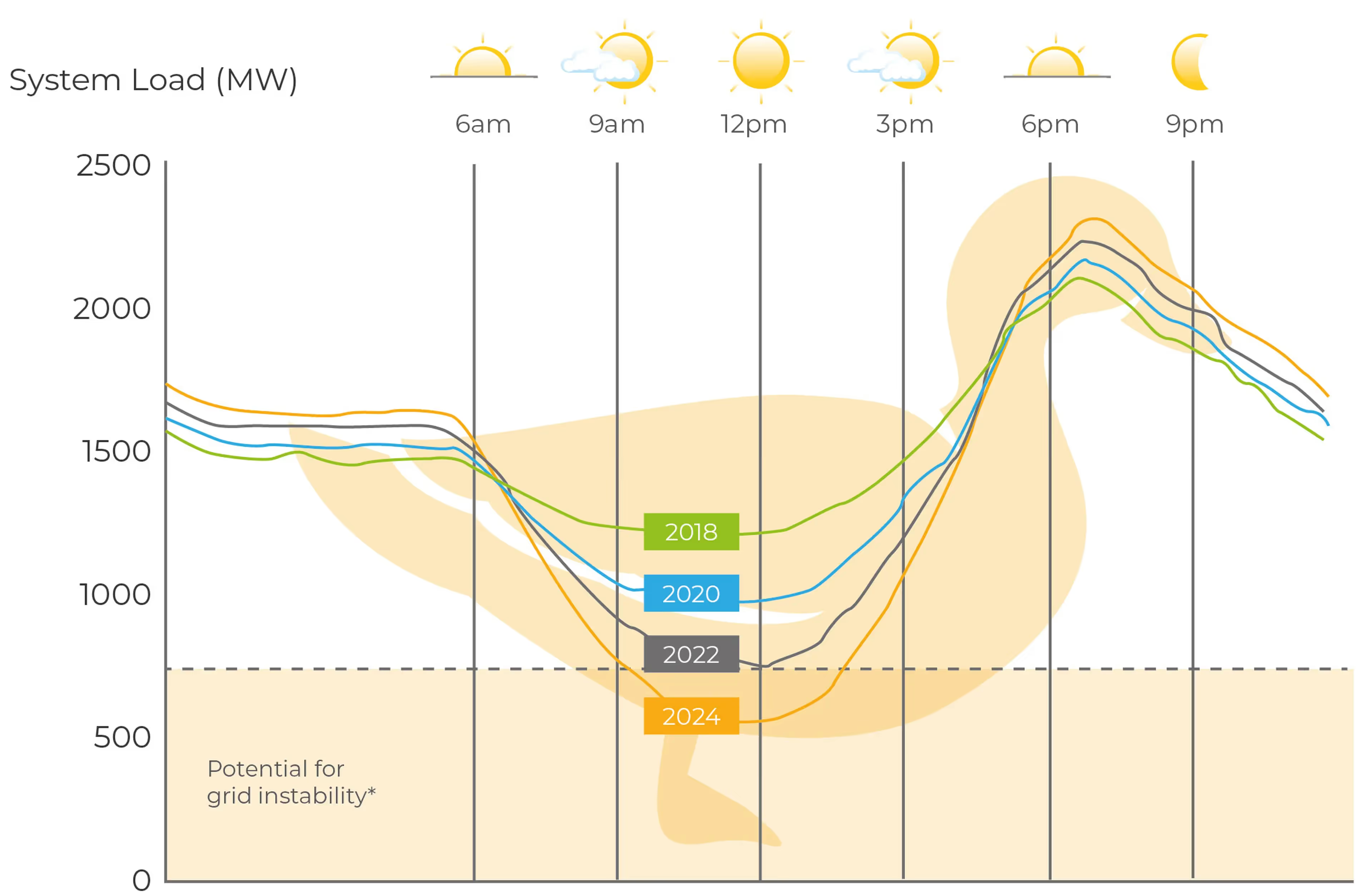Podero integrates with Smartcar to help utilities in Europe scale EVs for renewable energy management by optimizing charging schedules and reducing consumer energy costs. With our API, Podero seamlessly connects to a wide range of EV brands, helping users maximize renewable energy and lower emissions.
The cost of renewable energy is lower than it’s been in the past decade. Research shows that the levelized cost of energy for sources like wind and solar is competitive now with that of traditional fossil fuels — even without subsidies. In the European Union, renewable energy accounted for almost 45% of all electricity production in 2023. Wind and solar energy were the major drivers here.
But from the rapid production of renewable energy comes a new problem. The duck curve.
The duck curve is what happens when spikes in renewable energy production occur during the times consumers don’t need it. A perfect example of this is our tendency to use heaters, air conditioners, and EV chargers right when the sun sets. It just so happens that the periods of time with high energy consumption coincide with hours when green electricity isn’t in abundance.

The duck curve prevents utilities from fully maximizing available energy resources to meet consumer demand while minimizing costs. We’ve explored this topic before on the Smartcar blog about how power grids in the US use DERMS software to get real-time visibility into EV charging behavior and renewable energy generation to control how and when customers use their distributed energy resources.
“There are many solutions to this problem, but only one that doesn’t require technological, regulatory, or other miracles: We must shift power consumption to favorable times wherever we can,” says Chris Bernkopf, Co-founder at Podero, in an article on LinkedIn.
Driving this power shift requires coordination at scale across a robust energy ecosystem. All players in this ecosystem need to be in perfect symphony, spurred forward by the right goals, technology, and measures of success. And that’s not easy to do in a space that’s as complex and heavily regulated as energy.
Podero helps utilities orchestrate device flexibility
Podero is stepping up to address the issue of technology coordination in an ecosystem made up of consumers, utilities, manufacturers, grid operators, regulators, and more. By using financial incentives, Podero helps utilities manage their distributed energy resources (DERs) — such as electric vehicles (EVs), photovoltaic (PV) systems, and other household devices — and participate in energy markets at the most advantageous times for everyone involved.
“We believe that we can only convince everyone to participate by distributing the massive cost savings generated by using more of the cheapest energy sources,” Bernkopf explains in that same article.
Podero steers energy usage in real-time, synchronizing with PV production, spot markets, and balancing energy markets. This allows consumers to reduce their energy costs by up to 27.4%. Consumers can enroll in the service using Podero’s white-label app or via the utilities apps that have integrated Podero’s API. Meanwhile, Podero aggregates the energy flexibility of the device fleet to enable utilities to generate new revenue streams by trading on the electricity markets.
Podero helps utilities integrate more EVs into the energy markets
There’s a big opportunity in Europe for utilities to effectively manage their customer’s electric vehicles. By 2030, there will need to be at least 40 million electric vehicles in the region and at least 4 million publicly accessible charging points.
The abundance of consumer-owned devices like EVs has shifted the power system’s linear energy system into a decentralized structure dominated by renewable energy sources. But for this system to work, consumers need to be incentivized to adopt these new technologies and commit to this evolved power infrastructure.
Podero’s platform simplifies the process for utilities to drive this consumer behavior through accurate load forecasts and coordinated EV charging that doesn’t interrupt a driver’s daily routine or preferred habits. To help utilities steer EV charging to the times when renewable energy is abundant, Podero needed to enable seamless communication between customer devices and utility insights.
That’s where Smartcar comes in. By integrating with Smartcar’s API, Podero can provide utilities with standardized access to critical EV data, such as state of charge (SOC), battery capacity, charging status, and the ability to start and stop charging remotely. Smartcar’s platform offers:
- Standardized APIs that unlock EV interoperability, security, and infrastructure agility
- Developer-friendly SDKs and comprehensive API documentation
- User-friendly, consent-based authorization packaged in a modern UI
With Smartcar, we can steer each device individually, forecast its behavior, and trade the aggregate charging power on the electricity markets.
— Chris Bernkopf, Co-founder at Podero.
How Podero evaluated Smartcar as their EV API platform
.png)
✅ Pricing
✅ EV compatibility
✅ API capabilities
✅ Quality of customer support
✅ Opportunities to collaborate on EV compatibility expansion
Podero wanted a long-term EV API partner that they could rely on as the number of customer EVs connected to their platform grew. Customer support was a crucial factor in Podero’s vendor evaluation process, and ultimately, this became a big differentiator between Smartcar and other solutions in the market.
Unlocking cost savings and utility revenue streams with device flexibility
“We would like to reach as many consumers as possible to accelerate the transition to green energy,” says Bernkopf. “Smartcar is a key partner of Podero to work towards our mission.”
Podero aims to build the largest fleet of compatible energy-efficient devices to help utilities maximize renewable energy usage and bring consumers another step closer to a low-emission lifestyle. Through partnerships and close collaboration with manufacturers, regulatory agencies, and utilities, Podero is geared up to empower energy markets with stronger tools to control consumer devices and optimize energy trading for the highest impact. Learn more about Podero by visiting their website.




.jpg)

